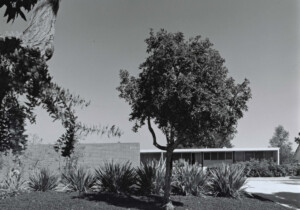On Friday, the LA Times’ architecture critic Christopher Hawthorne reported that Craig Ellwood and Jerrold Lomax’s Hunt House in Malibu faces a demolition threat. AN reached out to several experts on Ellwood, preservation, and modern architecture for comments on what this means for Los Angeles.
Designed in 1957, the modest beachside home built for Victor and Elizabeth Hunt is considered an iconic piece of midcentury architecture. Late last year, Hawthorne noted, documents were filed with the Malibu Planning Commission to replace the 1,335-square-foot Hunt House (sold in 2012 for $5.3 million) with a “a new 28-foot-tall, two-story, 5,511-square-foot single-family residence.”
“The Hunt House looming demolition is a textbook case of artwork misread as real estate object,” wrote architect and educator Pierluigi Serraino in an email. As author of numerous writings on midcentury design, including California Modernism (Chronicle Books, 2006), he put a fine point not on the historic value or the property value, but on the true cultural value of the structure. “This is one of the landmark buildings of California Modernism and its potential loss would be sheer loss of cultural identity. Collector value as opposed to real estate value can provide a more apt lens to evaluate this small inventory of gems,” he continued. “Imagine if what is threatening the Hunt House happened to the Eames House. [The] proposed demolition speaks to the utter disregard a selected few have for what belongs symbolically to the collective.”
In 1967, Esther McCoy was commissioned to write an essay for the Craig Ellwood monograph published by Bruno Alfieri the following year. In it, she discusses how the Hunt House by Ellwood and Lomax (who is uncredited) sets the tone for the firm’s work to come and solidifies its influences. “McCoy’s essay points out Ellwood’s love for good detailing, adherence to logic (“the logic of steel”), independent spirit, and a sense of refinement informed by the ‘full stark splendor’ of Mies and modular principles found in Japanese houses and industrial buildings,” noted Susan Morgan, editor of Piecing Together Los Angeles: An Esther McCoy Reader. “[McCoy] wrote that the Hunt House—with its H-plan, distinct volumes and levels—was very important in Ellwood’s development: The three space frames are more three-dimensional Mondrian than Mies.”
Morgan also reminded AN that the Hunt House features in Reyner Banham’s Architecture of Four Ecologies as the northernmost edge of Surfubria, his first ecology on beaches. Rudolph Schindler’s Lovell Beach House marks the southern boundary.
The Hunt House, like other midcentury designs, is particularly vulnerable to demolition due to trends for larger homes, maintenance issues, and land values. “It’s worth noting that the City of Malibu has no protections for its historic places and got an F on our 2014 Preservation Report Card,” said Los Angeles Conservancy’s Director of Communications Cindy Olnick.
In October, the Los Angeles Conservancy sent a letter to Malibu Planning Commission calling for an “Environmental Impact Report (EIR) prior to the approval of any project that would adversely impact the building.” The organization urges individuals concerned about the fate of the house to write to the commission via Malibu City Hall.










